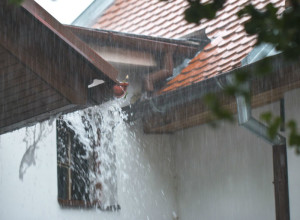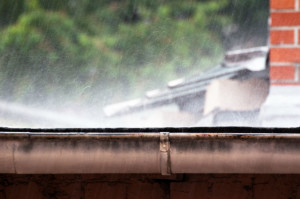Chimney systems are deceptively simple. For example, a simple stone column actually consists of several different components. They all need care and maintenance in order to keep your fireplace burning safely and efficiently. One of the most important – yet often ignored – chimney components is the chimney crown.
What is a chimney crown?
The chimney crown is the concrete or masonry slab that sits on top of the chimney structure, sealing around the flue. Quality chimney crowns slope gently down and away from the flue to prevent a buildup of moisture on top of the chimney crown. This helps prevent chimney leaks and water entering the chimney system.
What causes chimney crown damage?
Improper installation or construction often causes chimney crown damage. Because of their location and exposure to moisture and the elements, it is extremely important that chimney crowns are built using quality construction practices and materials. If not, the crown can deteriorate prematurely.
While bricks and mortar are ideal building materials for the chimney structure, they are unsuited for use in a chimney crown. Mortar-based mixes are significantly more susceptible to water damage; moisture, sun exposure, and changing temperatures can cause mortar-based crowns to crack and age.
Crowns built without an adequate slope deteriorate prematurely. When the chimney crown is too flat, moisture from rain, sleet, snow, and other sources can pool on top of the chimney instead of running off onto the roof. Over time, this can cause cracks and holes to form in the chimney crown.
Temperature disparity can also cause damage to the chimney crown. During the winter, exposure to cooler air temperatures causes the crown to become cold. However, when the fireplace is in use the flue can become extremely hot as it vents; the disparity in temperature between the flue and the chimney crown can cause the stone to expand and contract, opening it up to water damage.
Was my chimney crown properly built?
Few homeowners spend a significant amount of time on their roof or looking at their chimney. Therefore, it can be difficult to spot damage or deterioration to the chimney crown. The best way to evaluate the condition of your chimney crown is through a thorough chimney inspection by a certified professional.
When inspecting a chimney crown, the sweep will check to see what material the crown is made of. Concrete, stone, or even metal make up durable chimney crowns. The crown should be a single, solid piece to avoid water seeping into cracks or joints.
The edges of the chimney crown should also extend beyond the sides of the chimney. This overhang, called a kerf, keeps water from flowing directly onto the sides of the chimney. If water damage has begun to occur, a waterproof sealant can be applied to the chimney crown to prevent further damage.
A quality chimney crown can protect and extend the life of your fireplace system. For more information on chimney crowns or to schedule an appointment, contact Jack Pixley Sweeps today.
While Jack Pixley Sweeps may be the name you trust for all your fireplace and chimney needs, we can take care of other areas of your home too! Did you know we also offer professional gutter cleaning services? Having your gutters cleaned is a wonderful way to maintain your home’s exterior while keeping water out of your house.
Why do I need to have my gutters cleaned?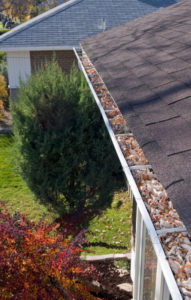
Gutters protect both the interior and exterior of your home by directing water away from the house and safely into drainage areas away from your home. While we often take gutters for granted when they are working properly, good gutters can protect the foundation, windows, siding, and interior ceilings and walls in your home.
Gutters aren’t just important on rainy days; they can also help protect your home during winter weather. The presence of gutters prevents large icicles from forming directly on the shingles of your roofline. This added barrier of protection prevents the icicles from pulling on the shingles while minimizing the risk of water entry.
What are the benefits of clean gutters?
Having clean gutters can prevent water damage in and around your home. Functioning gutters keep water away from the roof, foundation, siding, and windows of your home; this, in turn, keeps water from damaging ceilings, walls, and floors inside your home. Having clean gutters can also have unexpected benefits, such as preventing mold, mildew, and rotting wood. Likewise, this can help reduce the risk of termite infestation as the insects are drawn to the moisture.
How often should I clean my gutters?
How often you need to have your gutters cleaned can depend on a number of factors including location of your home, number of trees nearby, and the kinds of trees and foliage surrounding your home. While most homeowners need to have their gutters cleaned twice per year, the number or kinds of trees surrounding your home can impact how much debris accumulates. The more leaves, pinecones, branches, and other debris that accumulate on your roof or in your gutters, the more often your gutters need to be cleaned.
How can I tell if my gutters need to be cleaned?
There are a number of ways to tell if it is time to have your gutters cleaned.
- Visible debris or blockages in the gutters. This includes bird nests, leaves, branches, and even lost toys and balls.
- Water overflowing from the gutters during rain storms, especially if it is not raining hard
- Water damage along the side of the home or water pooling on the sides of the home
- Water dripping from the gutters even if it has not recently rained
- The presence of water in the basement not caused by a plumbing leak
If you trust Jack Pixley Sweeps to take care of your fireplace and chimney, trust us with other areas of your home too. Contact us today for more information on our professional gutter cleaning services or to schedule an appointment.
While a little water in your fireplace might seem like only a minor inconvenience, it can spell major trouble for your chimney system. Whether it’s a few droplets, a large puddle, or even a musty smell, the presence of water in your fireplace and chimney can cause damage to many different chimney components.
Causes of leaky chimneys
Because chimneys are complex structures with a number of different components, there is no one guaranteed cause of a leaky chimney. However, there are several common ways that water can get in; below are four of the most common causes of chimney leaks.
- Chimney cap: Chimney caps are metal covers that protect the top of the flue and keep animals, debris, and moisture out of the chimney. If a chimney cap is installed incorrectly, does not fit properly, or is damaged, water can easily enter the flue and chimney.
- Chimney crown: The chimney crown is the mortar slab that covers and seals the top of the chimney. Well-built chimney crowns are typically made of concrete or other stone to prevent the chips and cracks associated with long term exposure to the elements. Likewise, a good chimney crown should have overhangs and be slightly sloped in order to prevent water from pooling or draining directly onto the masonry of the chimney.
- Damaged masonry: Damage caused by water can cause bricks to crack and spall; not only does this let additional water into the fireplace system, but it can also affect the structural stability of the chimney structure.
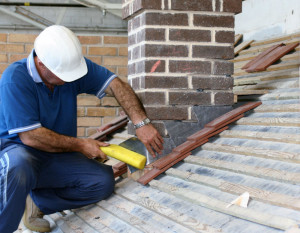
- Flashing: Chimney flashing are the layered metal strips that seal the joint between the roof and the chimney structure. Flashing can lose its watertight seal due to exposure to the elements, incorrect installation, damage from storms, or if changes to the roof line are made.
Repairing a leaky chimney
The first step to fixing a leaky chimney is to identify and repair the underlying cause of the leak. A chimney inspection done by a certified chimney sweep is often the best way to uncover where water is getting into the chimney system; by fixing how the water is getting in first, you can avoid needing the same chimney repairs because of water damage again and again.
In addition to repairing your leaky chimney, preventative maintenance can be done to protect your chimney against water damage. Waterproofing is one of the best ways to protect your masonry against water entry. Our professional-grade SaverSystems sealants are specially designed to work on masonry; these sealants allow the masonry to retain its semi-porous nature, allowing gasses to pass through but preventing moisture from getting in. Water repellent sealants can even be used if your masonry already has areas of water damage!
If you have a leaky chimney, it is important to have it repaired as soon as possible. Contact the experts at Jack Pixley Sweeps today for more information on how we can fix your leaky chimney!
When it comes to the weather, the old adage is true – April showers do bring May flowers! Unfortunately, spring showers can do more than just revitalize your garden after a long winter; they can also cause chimney damage. Water damage is often the primary cause of chimney deterioration. However, homeowners don’t have to sit idly by and watch the elements destroy their chimney. Instead, fight back against water damage by having your chimney waterproofed.
How water damages your chimney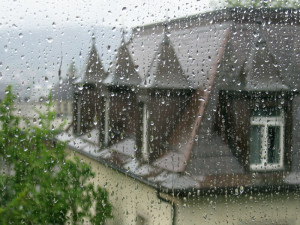
Although they are built to stand up to the elements, water is one of the most damaging forces to any chimney or masonry structure. Because bricks are naturally porous – which makes them the ideal building material for chimneys – they can absorb small amounts of water. Over time, this water can cause the masonry to crack, chip, or spall; this damage is often made worse by winter weather because of the freeze/thaw cycle.
The masonry damage caused by water entry is more than just an aesthetic problem. Damaged masonry can cause problems throughout your fireplace system, including chimney leaks. A chimney leak caused by cracked or spalled bricks can damage the surrounding masonry and building materials as well as other fireplace components. Dampness in the flue or firebox, water damage to roofs and walls surrounding the chimney, or cracked or missing bricks can all be signs of damaged masonry causing a chimney leak.
Protect your masonry through waterproofing
To protect your chimney from water damage caused by spring rains, consider having your masonry waterproofed. Waterproofing is preventative maintenance that can best protect your masonry against damage caused by water from rain, snow, ice, sprinklers, hoses, and other sources.
Our waterproofing products
When it comes to waterproofing your chimney, using the right products matters. In order to allow the masonry to retain its porous nature, special chimney-specific products should be used. At Jack Pixley Sweeps, we use and recommend three products by SaverSystems to our customers: ChimneySaver, CrownCoat, and FlashSeal.
- ChimneySaver: ChimneySaver is one of the longest-lasting water repellents available for chimneys. It can penetrate as deep as ¼ inch in most areas of the chimney, creating a strong bond with the masonry that will keep water out of years to come.
- CrownCoat: CrownCoat is a waterproof sealant designed for chimney crowns or washes. CrownCoat bonds with the cement of the chimney crown, protecting it from water entry and further damage to the concrete. CrownCoat also comes with a 15 year warranty against water intrustion.
- FlashSeal: FlashSeal is a rubber membrane that can be applied over your existing flashing to seal it against water entry. This is extremely important as faulty flashing is one of the main sources of chimney leaks. FlashSeal can reinforce existing flashing and is guaranteed to last up to seven years when correctly installed.
This year, don’t let spring rains damage your chimney; instead, protect your masonry by having it waterproofed. For those in the Minneapolis area, contact Jack Pixley Sweeps today for more information on our waterproofing services and to schedule your next appointment!


